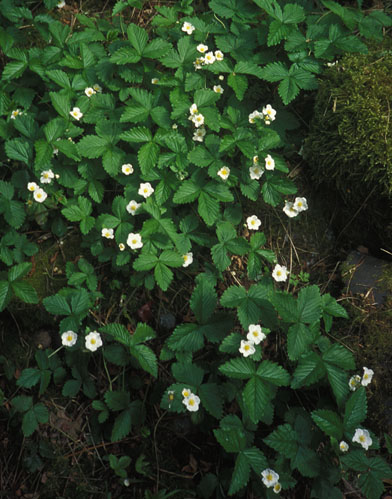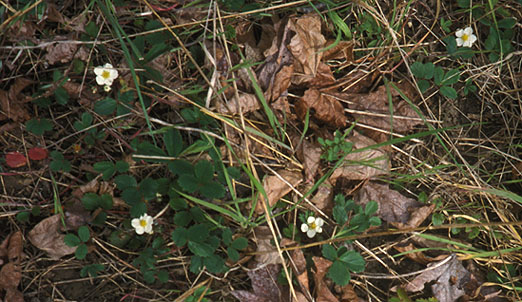Strawberries
|
Strawberries are later than usual this year, but taste as sweet as ever.
By mixing diverse kinds and planting them in different spots, you
can harvest fresh strawberries for eating between mid-May and early
November. The main season is early June through early October.
Even apartment dwellers can enjoy strawberries, by raising them in pots or
by picking them wild. Since we are all accustomed to the typical
supercharged hybrid strawberries of produce stands --the wild and
smaller kinds should be given the spotlight. Their lack of size is compensated
by the plants being easier to grow, at least in the long run. One such
novelty is 'Pink Panda' (also called 'Serenata'), the pink-flowered
strawberry. Patented in 1991, it has been used successfully as a groundcover
for banks, where its adaptable, spreading nature, pretty pink flowers
and tasty deep red fruit are a winning combination. Its berries vary in size
but are often more or less an inch, and roundish. What looks to be a
seedling of it with larger, darker flowers is
'Lipstick.'
|

|
| Leaving the nurseries, and turning to the wild, we have
"woodland strawberries" (Fragaria vesca) PHOTOGRAPHED ABOVE, native over much of the northern hemisphere, including Seattle. Like most strawberries, the kinds found
wild here spread by runners. As the name suggests, they tolerate shade;
their berries are either round or pointed, about half an inch to one inch
long. A European variation of the woodland strawberry is called
"alpine strawberry," with similar leaves and fruit, but with a longer season
of bearing (Fragaria vesca f. semperflorens). A second form (Fragaria
vesca f. eflagellis) grows taller and clumps only, rather than spreading in
mats; this runnerless alpine form reseeds freely in gardens but can scarcely
be called naturalized in Seattle. Similarly not wild in Seattle, but
available from gardeners or nurseries, there are at least 7 named cultivars of
white or yellow-berried woodland and alpine strawberries; slugs are less
likely to eat the white berries, apparently thinking they are not ripe. |
The "beach" or "evergreen strawberry" (Fragaria chiloensis) has
dark green, high-gloss thick evergreen leaves, showy white flowers, and is
a charming groundcover ornamental, but is practically never fruitful
in local cultivation. It is not native in Seattle, ranging from Alaska down
the coast to California, skirting western South America, and Hawaii.
If anyone knows the answer to its usual barren state in cultivation,
share your secret: likely two different clones are needed for fertilization,
since the flowers are functionally unisexual.
|

|
| A seldom cultivated native species is the
"blueleaf strawberry" (Fragaria virginiana) PHOTOGRAPHED ABOVE. In our area it is rare compared to the woodland species
(I've found it wild only once in Seattle), prefers more exposed sites, and
its leaves are definitely blue-green rather than pure or yellow-green. |
So, there are the main strawberries of our living city. Other plants
with the name strawberry, but not of the genus Fragaria, include mock strawberry, barren strawberry, strawberry tree, strawberry blite,
strawberry guava.
|
(originally published in The Seattle Weekly, July 1996)
Back |
|
|

